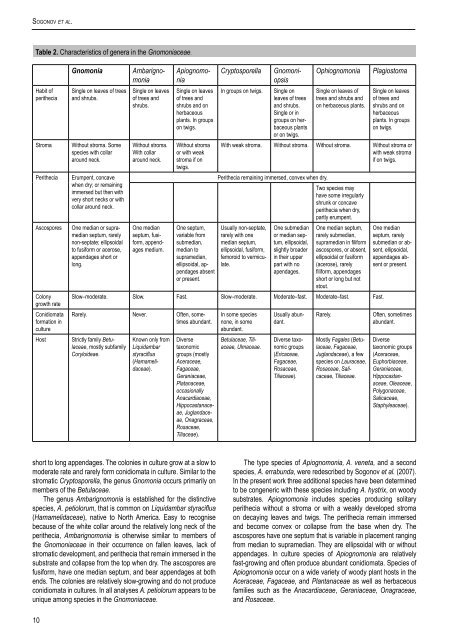Leaf-inhabiting genera of the Gnomoniaceae, Diaporthales - CBS
Leaf-inhabiting genera of the Gnomoniaceae, Diaporthales - CBS
Leaf-inhabiting genera of the Gnomoniaceae, Diaporthales - CBS
You also want an ePaper? Increase the reach of your titles
YUMPU automatically turns print PDFs into web optimized ePapers that Google loves.
So g o n o v e t a l.<br />
Table 2. Characteristics <strong>of</strong> <strong>genera</strong> in <strong>the</strong> <strong>Gnomoniaceae</strong>.<br />
Habit <strong>of</strong><br />
peri<strong>the</strong>cia<br />
Stroma<br />
Peri<strong>the</strong>cia<br />
Ascospores<br />
Colony<br />
growth rate<br />
Conidiomata<br />
formation in<br />
culture<br />
Host<br />
Gnomonia<br />
Single on leaves <strong>of</strong> trees<br />
and shrubs.<br />
Without stroma. Some<br />
species with collar<br />
around neck.<br />
Erumpent, concave<br />
when dry; or remaining<br />
immersed but <strong>the</strong>n with<br />
very short necks or with<br />
collar around neck.<br />
One median or supramedian<br />
septum, rarely<br />
non-septate; ellipsoidal<br />
to fusiform or acerose,<br />
appendages short or<br />
long.<br />
Without stroma.<br />
With collar<br />
around neck.<br />
One median<br />
septum, fusiform,<br />
appendages<br />
medium.<br />
Without stroma<br />
or with weak<br />
stroma if on<br />
twigs.<br />
One septum,<br />
variable from<br />
submedian,<br />
median to<br />
supramedian,<br />
ellipsoidal, appendages<br />
absent<br />
or present.<br />
Cryptosporella<br />
In groups on twigs.<br />
Ambarignomonia<br />
Single on leaves<br />
<strong>of</strong> trees and<br />
shrubs.<br />
Apiognomonia<br />
Single on leaves<br />
<strong>of</strong> trees and<br />
shrubs and on<br />
herbaceous<br />
plants. In groups<br />
on twigs.<br />
Gnomoniopsis<br />
Single on<br />
leaves <strong>of</strong> trees<br />
and shrubs.<br />
Single or in<br />
groups on herbaceous<br />
plants<br />
or on twigs.<br />
Ophiognomonia<br />
Single on leaves <strong>of</strong><br />
trees and shrubs and<br />
on herbaceous plants.<br />
Plagiostoma<br />
Single on leaves<br />
<strong>of</strong> trees and<br />
shrubs and on<br />
herbaceous<br />
plants. In groups<br />
on twigs.<br />
With weak stroma. Without stroma. Without stroma. Without stroma or<br />
with weak stroma<br />
if on twigs.<br />
Peri<strong>the</strong>cia remaining immersed, convex when dry.<br />
Two species may<br />
have some irregularly<br />
shrunk or concave<br />
peri<strong>the</strong>cia when dry,<br />
partly erumpent.<br />
Usually non-septate,<br />
rarely with one<br />
median septum,<br />
ellipsoidal, fusiform,<br />
femoroid to vermiculate.<br />
One submedian<br />
or median septum,<br />
ellipsoidal,<br />
slightly broader<br />
in <strong>the</strong>ir upper<br />
part with no<br />
apendages.<br />
One median septum,<br />
rarely submedian,<br />
supramedian in filiform<br />
ascospores, or absent,<br />
ellipsoidal or fusiform<br />
(acerose), rarely<br />
filiform, appendages<br />
short or long but not<br />
stout.<br />
Slow–moderate. Slow. Fast. Slow–moderate. Moderate–fast. Moderate–fast. Fast.<br />
Rarely. Never. Often, sometimes<br />
abundant.<br />
Strictly family Betulaceae,<br />
mostly subfamily<br />
Coryloideae.<br />
Known only from<br />
Liquidambar<br />
styraciflua<br />
(Hamamelidaceae).<br />
Diverse<br />
taxonomic<br />
groups (mostly<br />
Aceraceae,<br />
Fagaceae,<br />
Geraniaceae,<br />
Platanaceae,<br />
occasionally<br />
Anacardiaceae,<br />
Hippocastanaceae,<br />
Juglandaceae,<br />
Onagraceae,<br />
Rosaceae,<br />
Tiliaceae).<br />
In some species<br />
none, in some<br />
abundant.<br />
Betulaceae, Tiliaceae,<br />
Ulmaceae.<br />
Usually abundant.<br />
Diverse taxonomic<br />
groups<br />
(Ericaceae,<br />
Fagaceae,<br />
Rosaceae,<br />
Tiliaceae).<br />
Rarely.<br />
Mostly Fagales (Betulaceae,<br />
Fagaceae,<br />
Juglandaceae), a few<br />
species on Lauraceae,<br />
Rosaceae, Salicaceae,<br />
Tiliaceae.<br />
One median<br />
septum, rarely<br />
submedian or absent,<br />
ellipsoidal,<br />
appendages absent<br />
or present.<br />
Often, sometimes<br />
abundant.<br />
Diverse<br />
taxonomic groups<br />
(Aceraceae,<br />
Euphorbiaceae,<br />
Geraniaceae,<br />
Hippocastanaceae,<br />
Oleaceae,<br />
Polygonaceae,<br />
Salicaceae,<br />
Staphyleaceae).<br />
short to long appendages. The colonies in culture grow at a slow to<br />
moderate rate and rarely form conidiomata in culture. Similar to <strong>the</strong><br />
stromatic Cryptosporella, <strong>the</strong> genus Gnomonia occurs primarily on<br />
members <strong>of</strong> <strong>the</strong> Betulaceae.<br />
The genus Ambarignomonia is established for <strong>the</strong> distinctive<br />
species, A. petiolorum, that is common on Liquidambar styraciflua<br />
(Hamamelidaceae), native to North America. Easy to recognise<br />
because <strong>of</strong> <strong>the</strong> white collar around <strong>the</strong> relatively long neck <strong>of</strong> <strong>the</strong><br />
peri<strong>the</strong>cia, Ambarignomonia is o<strong>the</strong>rwise similar to members <strong>of</strong><br />
<strong>the</strong> <strong>Gnomoniaceae</strong> in <strong>the</strong>ir occurrence on fallen leaves, lack <strong>of</strong><br />
stromatic development, and peri<strong>the</strong>cia that remain immersed in <strong>the</strong><br />
substrate and collapse from <strong>the</strong> top when dry. The ascospores are<br />
fusiform, have one median septum, and bear appendages at both<br />
ends. The colonies are relatively slow-growing and do not produce<br />
conidiomata in cultures. In all analyses A. petiolorum appears to be<br />
unique among species in <strong>the</strong> <strong>Gnomoniaceae</strong>.<br />
The type species <strong>of</strong> Apiognomonia, A. veneta, and a second<br />
species, A. errabunda, were redescribed by Sogonov et al. (2007).<br />
In <strong>the</strong> present work three additional species have been determined<br />
to be congeneric with <strong>the</strong>se species including A. hystrix, on woody<br />
substrates. Apiognomonia includes species producing solitary<br />
peri<strong>the</strong>cia without a stroma or with a weakly developed stroma<br />
on decaying leaves and twigs. The peri<strong>the</strong>cia remain immersed<br />
and become convex or collapse from <strong>the</strong> base when dry. The<br />
ascospores have one septum that is variable in placement ranging<br />
from median to supramedian. They are ellipsoidal with or without<br />
appendages. In culture species <strong>of</strong> Apiognomonia are relatively<br />
fast-growing and <strong>of</strong>ten produce abundant conidiomata. Species <strong>of</strong><br />
Apiognomonia occur on a wide variety <strong>of</strong> woody plant hosts in <strong>the</strong><br />
Aceraceae, Fagaceae, and Plantanaceae as well as herbaceous<br />
families such as <strong>the</strong> Anacardiaceae, Geraniaceae, Onagraceae,<br />
and Rosaceae.<br />
10

















